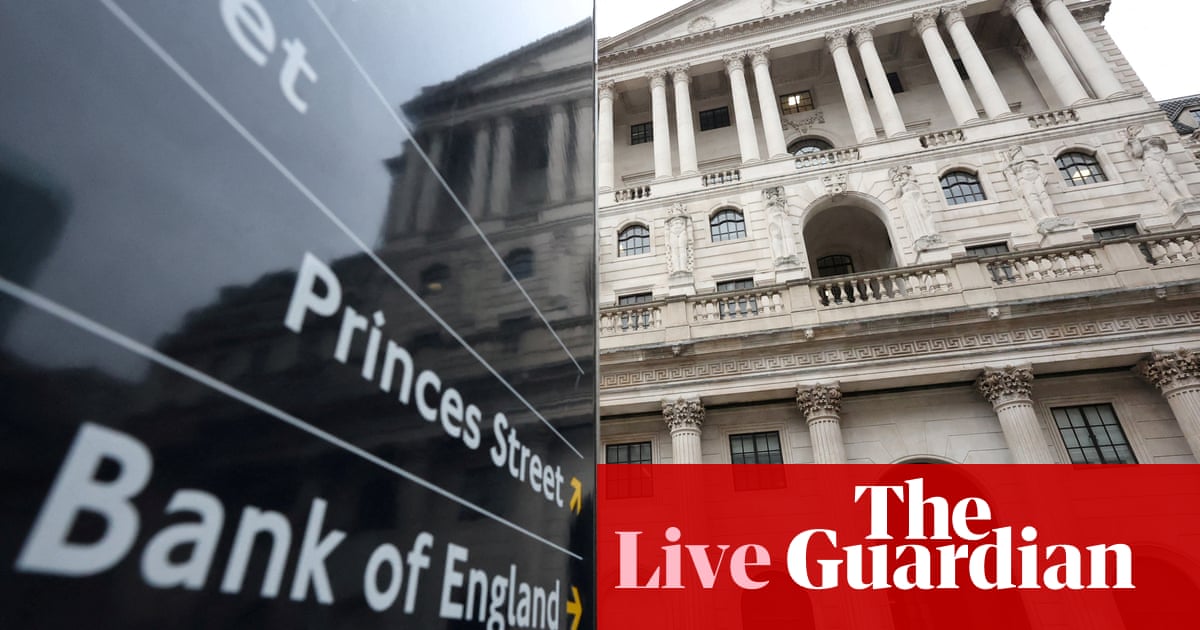UK construction sector shrinks amid economic uncertainty
Newsflash: Britain’s construction sector shrank unexpectedly last month, new data shows, raising concerns over the health of the UK economy.
Data provider S&P Global reports that business activity declined across UK construction in January for the first time since February 2024.
Output fell across housebuilding – despite the Labour government’s pledge to boost home construction – commercial property work and civil engineering.
Firms also reported a renewed fall in their order books, blamed on delayed decision-making by clients and general economic uncertainty.
This pulled the UK construction PMI down to 48.1 in January, down sharply from 53.3 in December, and below the 50-point mark showing stagnation.
This highlights the pressure on the Bank of England to cut interest rates at noon today to support the economy, and make borrowing cheaper.

Tim Moore, economics director at S&P Global Market Intelligence, says:
“UK construction output fell for the first time in nearly a year as gloomy economic prospects, elevated borrowing costs and weak client confidence resulted in subdued workloads.
Output levels decreased across the board in January, with particularly sharp reductions seen in the residential and civil engineering categories.
Construction firms noted the fastest fall in residential work for 12 months as market conditions remained somewhat subdued. Anecdotal evidence suggested that caution regarding demand for new projects was prevalent at the start of 2025, despite strong policy support for house building and hopes for a longer-term boost to supply via planning reform.
The forward-looking survey indicators were also relatively downbeat in January. New orders decreased at the fastest pace since November 2023 amid many reports of delayed decision-making by clients. Reduced workloads, combined with concerns about the general UK economic outlook, led to a dip in business activity expectations to the lowest for 15 months.
Key events
The Bank of England will be concerned to hear that nearly four in 10 UK businesses are hiking prices in response to the threat of tariff hikes as fears grow over a global trade war kicked off by US President Donald Trump.
A poll of 1,500 businesses by banking giant HSBC found 39% are increasing prices in anticipation of higher tariffs.
It also revealed that half of firms are shifting their export markets to countries with lower trade barriers in an effort to side-step the worst of the hit from any trade war.
Pound lower, FTSE 100 at new high
The pound has weakened further after this morning’s weaker-than-expected UK construction PMI report.
Sterling is now down almost a whole cent against the US dollar, at $1.242.
That’s lifting shares in multinational companies listed in London, which has pushed the FTSE 100 to a new alltime high of 8,733 points, up 1.25% today.
Today’s poll of purchasing managers at UK construction firms also found that input costs jumped at the fastest rate since April 2023, even though demand for construction products and materials fell.
The PMI report explains:
Construction companies noted that suppliers had sought to pass on rising energy, transportation and staff costs. Moreover, vendor performance deteriorated to the greatest extent for two years, which was partly linked to shipping delays.
UK housebuilding decreased for the fourth successive month in December, and at the fastest pace since January 2024, today’s PMI report shows.
General economic uncertainty, rising outgoings and stubborn rates; knock construction confidence. All three categories of construction work in @SPGlobalRatings UK constuction PMI showed a reduction in output during January 2025. The lack of civil engineering activity was put down… pic.twitter.com/2RI2CpMWDd
— Emma Fildes (@emmafildes) February 6, 2025
UK construction sector shrinks amid economic uncertainty
Newsflash: Britain’s construction sector shrank unexpectedly last month, new data shows, raising concerns over the health of the UK economy.
Data provider S&P Global reports that business activity declined across UK construction in January for the first time since February 2024.
Output fell across housebuilding – despite the Labour government’s pledge to boost home construction – commercial property work and civil engineering.
Firms also reported a renewed fall in their order books, blamed on delayed decision-making by clients and general economic uncertainty.
This pulled the UK construction PMI down to 48.1 in January, down sharply from 53.3 in December, and below the 50-point mark showing stagnation.
This highlights the pressure on the Bank of England to cut interest rates at noon today to support the economy, and make borrowing cheaper.
Tim Moore, economics director at S&P Global Market Intelligence, says:
“UK construction output fell for the first time in nearly a year as gloomy economic prospects, elevated borrowing costs and weak client confidence resulted in subdued workloads.
Output levels decreased across the board in January, with particularly sharp reductions seen in the residential and civil engineering categories.
Construction firms noted the fastest fall in residential work for 12 months as market conditions remained somewhat subdued. Anecdotal evidence suggested that caution regarding demand for new projects was prevalent at the start of 2025, despite strong policy support for house building and hopes for a longer-term boost to supply via planning reform.
The forward-looking survey indicators were also relatively downbeat in January. New orders decreased at the fastest pace since November 2023 amid many reports of delayed decision-making by clients. Reduced workloads, combined with concerns about the general UK economic outlook, led to a dip in business activity expectations to the lowest for 15 months.
The Bank of England is likely to cut interest rates at noon today to fight off the risk of the UK falling into recession.
It could also hint at further rate cuts soon, as Andrew Wishart, senior UK economist at Berenberg, explains:
● Fending off another recession: Alongside a widely anticipated 25bp reduction in the bank rate this Thursday 6 February, the Bank of England (BoE) may hint that it could lower interest rates again in March. Until now, the BoE has cut at alternate meetings, but a stagnating economy and declining employment argue for more urgent action. The central bank judged the labour market to be broadly in balance at the 18 December meeting, before payroll data for December revealed further job losses. On that basis, it is sensible for the BoE to lower interest rates to prevent a larger drop in employment. Chart 1 shows that policymakers tend to take corrective action when surveys of employment slump.
● New forecasts will support rate cuts: The BoE’s new forecast will be based on two interest rate cuts this year (market pricing during the 15-day averaging window in late January) as opposed to four in the previous edition. This, alongside disappointing growth, will depress the GDP and inflation projections. Quarterly GDP growth was zero in Q3 and most likely in Q4 too, falling short of the BoE’s forecasts of 0.2% qoq and 0.3% qoq respectively. Therefore, we expect the BoE to revise down its GDP forecast for 2025 from 1.5% yoy to 1.0% and lower its forecast for CPI inflation for Q1 2027 from 2.1% yoy in November to about 1.7%. A forecast of below 2% inflation in two years’ time is a signal that looser policy is needed.
● Not that simple: Not all of the Monetary Policy Committee (MPC) will be on board with that message, and the most hawkish member, Catherine Mann, is likely to dissent by voting to hold the policy rate unchanged at 4.75%. Rate cuts would be uncontroversial if the current downturn were driven purely by demand – but we doubt it is. In our view, the recent fall in employment is instead primarily a consequence of an impending rise in labour costs. A further increase in the minimum wage and a hike in payroll taxes on 1 April will raise the cost of low-paid and part-time employment substantially. The MPC has so far played down the acceleration in average weekly pay growth as a volatile aberration. But our analysis shows that the compression of the bottom half of the pay distribution by increases in the minimum wage over recent years means that the policy is now exerting upward pressure on headline measures of pay growth. A big increase in costs is a supply shock, and not one that monetary policy can directly counteract.
AstraZeneca’s shares are now up 5% after it beat City forecasts for revenue growth this morning.
That’s helping to drive the FTSE 100 to a new intraday peak (now 8,713 points!) this morning, as AstraZeneca is the most valuable company on the index.
Neil Wilson, analyst at TipRanks, reports:
The FTSE 100 hit a record high clear of 8,700 thanks to strong numbers from its largest weighting AstraZeneca, while traders in London also looked on hopefully to an expected rate cut by the Bank of England. The FTSE 100 rose 1% and the DAX added about 0.8% while the CAC in Parise rose 0.4% as European shares turned broadly higher amid a deluge of positive corporate earnings.
The record high shows that for all the doom and gloom, talk of trade wars and tariffs, and broad geopolitical risk, investors keep putting money to work at companies with good valuations.
Blockbuster cancer drugs helped AstraZeneca to beat quarterly estimates with revenues up 21%, sending shares up 5% to top the blue chips, while Anglo American dragged the miners sharply higher.
The FTSE 100 has made a fairly rollicking start to the year.
Since the start of 2025, the blue-chip share index has gained 6.5%, which is actually more than the 5.7% it gained during 2024.
The UK market may be benefiting from a ‘rotation’ out of technology stocks, where AI-focused firms were hit by the emergence of China’s DeepSeek last month.
FTSE 100 climbs over 8,700 to new high
Boom! The FTSE 100 index has now climbed over the 8,700-point mark for the first time.
The index has now gained almost 1% today to 8,704 points, a new record.
Today’s FTSE 100 record high comes almost five years after the markets crashed at the start of the Covid-19 pandemic.
In February 2020, the FTSE recorded its biggest weekly losses since 2008, briefly dropping through the 5,000 point mark in early March 2020 before rebounding:
Evelyn de Rothschild left bank in 2004 after sexual misconduct complaint

Anna Isaac
The financier Sir Evelyn de Rothschild left the bank that bears his family name in 2004 after an investigation into a sexual misconduct complaint, it has emerged.
Staff at Rothschild & Co were told on Wednesday that the late banker, who was a financial adviser to Queen Elizabeth II, left in March 2004 after the complaint in late 2003.
The Guardian revealed on Tuesday that several women had accused De Rothschild, who died aged 91 two years ago, of exploiting his position at the bank to abuse them while they worked with him.
Among the allegations are that he seriously sexually assaulted and harassed several women in the mid and late 1990s when they worked for NM Rothschild.
Markets across Europe are rallying, as “investors get some confidence back”, reports Matt Britzman, senior equity analyst at Hargreaves Lansdown, helping to push the FTSE 100 to a new all-time high.
Britzman says:
“UK markets are kicking off the day with a spring in their step, as the US tariff chatter finally quietens down, letting investors zero in on a wave of big earnings reports and hopes for another Bank of England rate cut – markets are practically betting the house on a quarter-point cut today.
This positive vibe is spreading across Europe, giving global markets a much-needed boost. Seems like investors may be ready to dance to the tune of good news again.
Germany’s DAX has risen by 0.6% in early trading, while France’s CAC is up 0.4%.
Article by:Source: Guardian Staff














